Several attempts have been made by flower growers to propagate such chic and popular flowers as roses by cuttings. However, only a small fraction of them were successful. Several ways to propagate roses using cuttings will be described below, and if you follow fairly simple rules, then it is quite possible to achieve success. This method of reproduction is considered the most successful in comparison with seed and grafting. The fact is that it is relatively simple, and it can be used even in the warm, even in the cold season. Because cuttings can be taken not only directly from the rose bush, but also used for this those that were presented to you as a bouquet.
Content
How to grow a rose from a cutting
Several ways
So, for cutting a rose, several completely different methods are used:
- the Trannoy way;
- Burito's way;
- rooting with a container filled with water;
- rooting in a potato tuber;
- rooting in a package;
- planting cuttings in open ground in the summer;
- rooting cuttings during the cold season.
The most natural way of rooting is summer in the open field. It is recommended to cut cuttings in the morning or evening hours. Semi-lignified stems that have only recently stopped blooming or are just blooming are best suited. The main sign that the shoot is suitable for grafting is when the thorns can be easily broken off. For cutting, you need to use a very sharp, pre-sterilized knife. The length of the cuttings varies from 12 to 15 centimeters, while each of them should have 2 or 3 leaves and the same number of buds. But there should be no flowers. The cut must be oblique. It is done directly under the knot at the bottom, as well as 15–20 millimeters above the top knot. All lower leaf plates, as well as thorns, must be cut off. In order for the moisture to remain as long as possible, experts advise either to remove the remaining leaves, or to shorten them, leaving 1/3 of them. To speed up rooting and make it more successful, you need to lower the lower part of the cuttings in a solution that stimulates rooting (root or heteroauxin), and wait a while.Also, as a root growth stimulant, you can use a mixture consisting of ½ part of a small spoonful of honey, 200 g of water and a few crushed rose leaves.
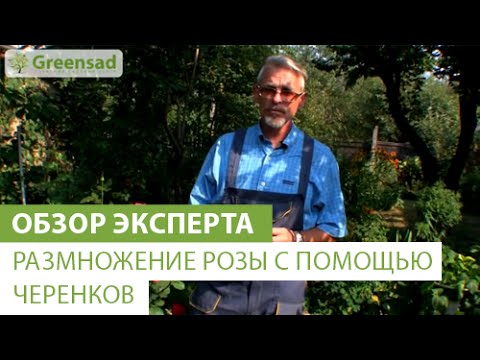

Watch this video on YouTube
Rose cuttings care
Rooting of the cuttings can be done directly in the open field. For planting, you will need a substrate consisting of nutrient-rich soil and coarse-grained washed river sand. Prepare the wells by watering them with a steep solution of potassium manganese. The stalk must be planted in the ground at an angle of 45 degrees, while the bud, which is at the very bottom, should be in the ground. After that, the cuttings need to be watered and covered with separate glass jars on top. If the temperature stays at least 25 degrees during the day and at least 18 degrees at night, the stalk will give roots after about 4 weeks, and a young shoot will appear from the bud. After half a month, you need to start hardening the plants. To do this, you need to remove the shelter every day, and after some time, return it again. After a few days of hardening, the shelter should be completely removed. By the onset of the autumn period, the plants will reach a height of 30–40 centimeters. The buds that appear should be removed, since all the forces of a young rose should go to the formation and growth of roots. This is the general principle of cutting roses.
In autumn, it is recommended to carefully dig up young plants and place them in a cellar together with a lump of soil for storage for the whole winter. If desired, the dug rose can be planted in a pot and placed in the house in a well-lit, cool place until spring comes.
Rooting rose cuttings in potatoes
You can root the cuttings of this plant in a potato tuber. To do this, a trench is burst in the spring, the depth of which should be about 15 centimeters. A place for it should be chosen sunny and protected from gusts of wind. A five-centimeter layer of sand should be poured onto the bottom. Prepare cuttings that should be about 20 centimeters long. All leaves and thorns must be cut off from them. Cut out all eyes from a young potato tuber of medium size. Stick the prepared stalk into the potato, and lower it into the trench. Bury 2/3 of the length, while the distance between the cuttings should be about 15 centimeters. In the early days, cuttings should be covered with glass jars. The success of such rooting lies in the fact that the part of the cuttings stuck into the tuber is in a constantly moist environment, and the plant is also saturated with starch and useful carbohydrates. This method is the most popular. Provide regular watering for the plants. At the same time, 1 time in 5 days they need to be watered with sweetened water, so, for 200 g of water, 2 small tablespoons of granulated sugar are taken. After half a month, start hardening young roses, removing the shelter for a while. After half a month, the shelter is removed for good.
Roses from cuttings of a bouquet
Rooting cuttings of roses from a bouquet is also very popular. But it is worth considering that for this it is necessary to use not imported, but domestic flowers. And that's all because imported flowers, before going to Russia, are treated with special chemicals that have a preservative effect, and therefore the cuttings are not capable of forming a root system. A few tips:
- For rooting, cuttings are used only from a fresh bouquet.
- The shoot must necessarily be a little lignified.
- The stalk should be of medium thickness and the buds are located at the very top and bottom (the stalk is cut in the same way as described above).
Root roses from a bouquet should be as soon as possible. This means that if you were presented with a bouquet, then they should be donated immediately. To do this, you need to cut off all available flowers and buds. The length of the cuttings can vary from 15 to 30 centimeters.From below, all sheet plates must be cut off, and those that are on top should be shortened by 2/3 of their length. The prepared cuttings are placed in a vase filled with distilled water. Next, you need to systematically replace the water until the first roots appear. After that, the cuttings should be planted in a pot in the cold season, and in the open ground in the warm season. Cover them with a glass jar.
Other ways to cut roses
Cuttings in a package
Prepared cuttings of roses must be put in a bag, into which a sterilized substrate or sphagnum moistened with a solution of aloe juice (1 part of juice and 9 parts of water) is previously poured. Then the bag should be inflated and tied well. It must be hung on the window. Due to the high humidity inside the bag, a kind of fog forms, and after about 4 weeks the first roots appear on the cuttings. Then they need to be landed, as described above.
Planting cuttings before winter
This method is used to preserve cuttings until the onset of spring. With the onset of warmth, they can give roots and start growing. The idea is that the cuttings will not take root until spring comes and will remain alive. The fact is that it is not always convenient to store the cutting in room conditions all winter. And sometimes, it is in autumn that truly unique varieties of roses come across. To do this, you need to dig the stalk into the soil. And in order to protect from winter frosts, a dry shelter must be placed on top. In springtime, transplant the cuttings to their usual place.


Watch this video on YouTube
Burito's way


Watch this video on YouTube
This method is quite ineffective, but it is still quite popular among flower growers. The lower part of the prepared cuttings must be treated with an agent that stimulates the formation of roots (epin or root). After that, the cuttings should be wrapped with damp newsprint and placed in a dark, cool (from 15 to 18 degrees) place for half a month. And after this period has expired, roots should form on the cuttings.
Trannois way
The meaning of this method is so that before cutting the shoots into cuttings, they can absorb the maximum amount of starch from the leaves. As a result, they will become more resilient and stronger. Experts advise that after the main flowering wave is completed (usually in June or July), it is necessary to select suitable shoots and cut off the upper part from them with a fading flower and 2 small leaf plates. After the buds swell at the bottom of these shoots, it is necessary to cut them into cuttings. This must be done in a fairly short time, without waiting for young leaves to appear from the buds. Cuttings should be cut as described above. Their length should be equal to 20 centimeters, and they need to cut off all the leaves, leaving only the top 2. These cuttings should be immediately planted in open ground at an angle of 45 degrees. In this case, it is recommended to plant several cuttings in one hole. Plastic bottles with a volume of 5 liters are used as a shelter, from which the upper narrow part should be cut off. They are not removed until the onset of the winter period, even if leaves and young shoots begin to grow. Cuttings should be provided with systematic watering, as well as loosening the soil.

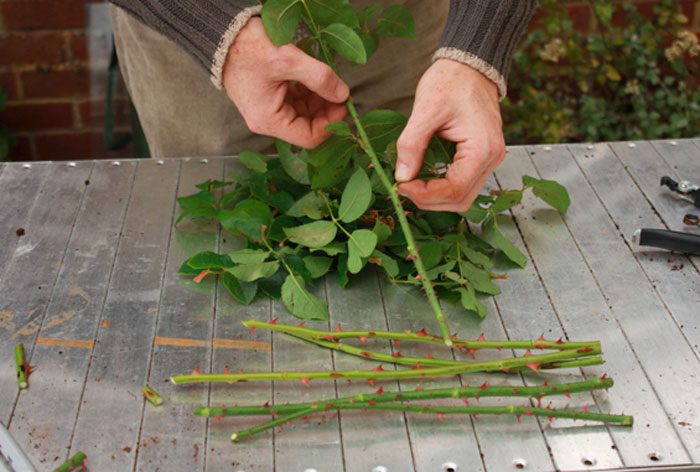
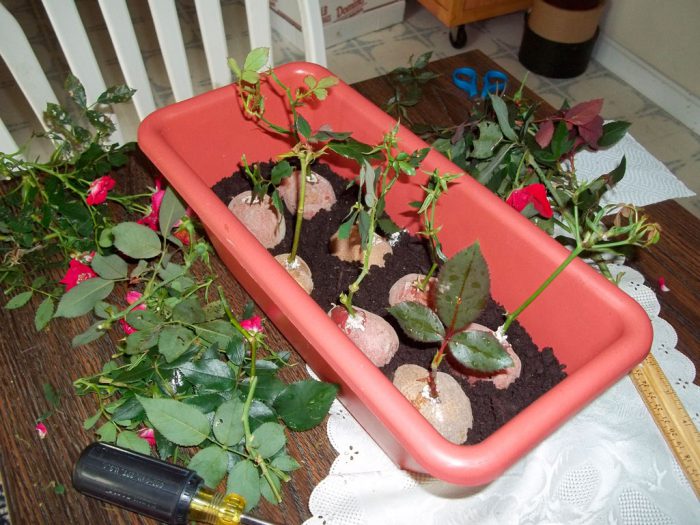
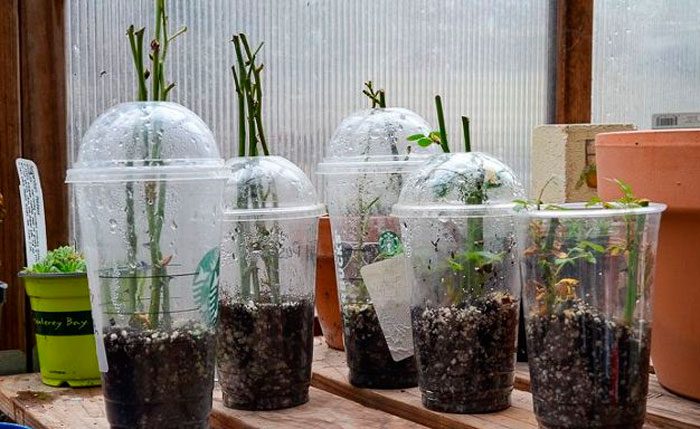
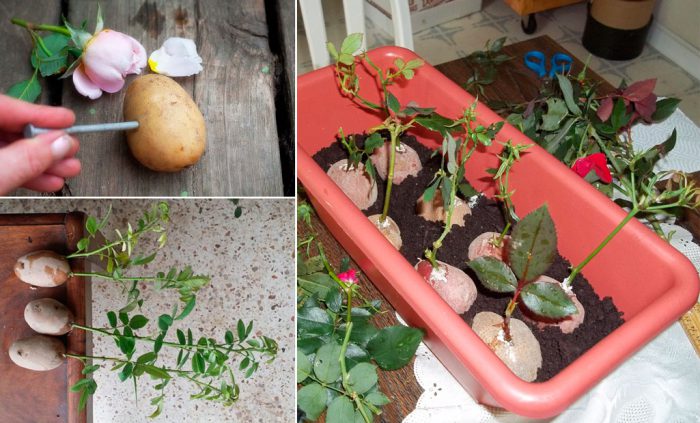
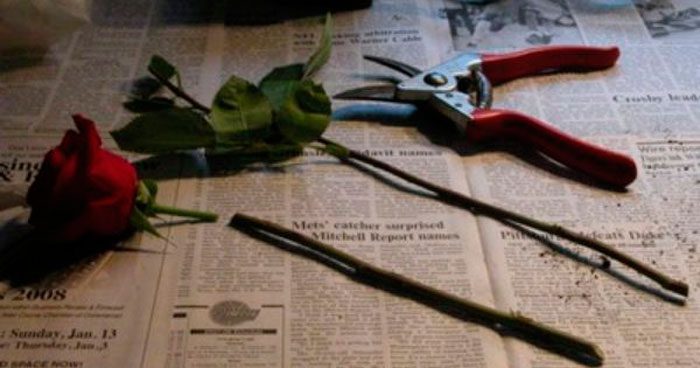
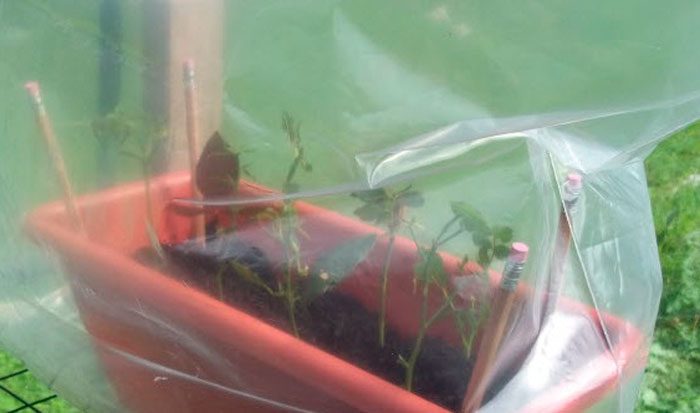







I planted a stem of a rose in the ground, because it gave a small root. Now almost a month has passed, there are no leaves, it is slightly covered with some kind of white moss. She took out the handle, the spine increased. Will she live at all, this rose?
Olga
On the site, roses take root with me without any problems, just covered with cut-off bottles, even roses from bouquets, but at home this is more difficult. But the main thing, as I understand it, can be taken in quantity, the more cuttings, the more chances that at least a couple will take root.